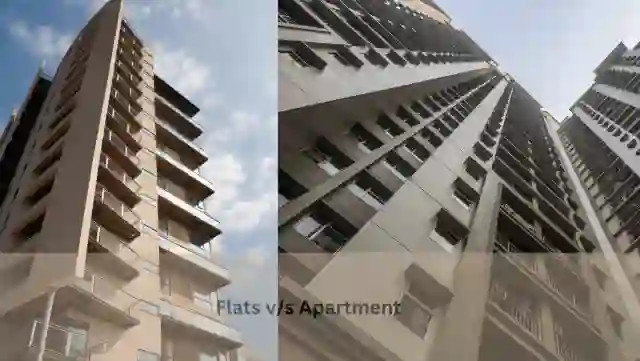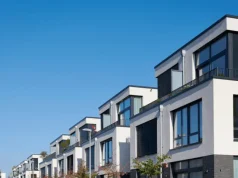So, you’ve decided to purchase a new home? When checking out a real estate listing, it is impossible to fail to notice the terms “flat” or “apartment.” The very thought of that makes my mind spin!
Can you swap them out? Is it possible to find the advantages and disadvantages of any option? We’ll simplify things for you, so kick back with your feet up.
Everybody has been there, weighing the pros and cons of the “flat” in a charming old building versus the “apartment” with a gym and a swimming pool, both of which seem like great possibilities. If consumers understand these concepts and their subtleties, they will be better able to make informed decisions while looking for a home. You will be able to choose the kind of home that best suits your family by using the information in this blog to have a deeper understanding of these subtleties.
Flat vs. Apartment – By definition
Unlike those typically found in a multi-story building, a flat is a self-contained residential unit. Apartments are very popular because of their small size and straightforward design. Although they come in a variety of sizes, even the largest ones are made to fit the needs of a single household. Flats can be part of a larger building, and their entry is typically shared with other flats in the same structure.
The term “apartment” can apply to separate living quarters in tall structures. Like flats, apartments come in a range of sizes and configurations. Apartment buildings usually have several stories, extra common areas, fitness centers, and swimming pools. They can also become a part of a wider society.
If you’re in search of a flat or apartment in Bangalore, we invite you to browse through our property listings
Size and Layout
| Aspect | Flats | Apartments |
| Dimensions | Generally more compact | Arrive in a range of sizes |
| Size within the same structure is typically more consistent. | Might differ dramatically even within the same structure or complex. | |
| Layout | In general, simple and effective | Provide more alternatives for layouts. |
| Usually, a single-story layout lacking an interior staircase | May consist of penthouses, duplexes, or single-story apartments. | |
| Key Differences | More consistent and small in size | More adaptable in terms of arrangement and size |
| Simplicity in Layout | Provides larger, more intricate layouts |
Also Read: How to convert residential property to commercial property
Cost and affordability
Flats
- Because of their small size, apartments are economical and practical.
- Because a flat building is more straightforward, construction and upkeep may require less money. Having the final word on care can save homeowners money, unlike renters.
Apartments
- The initial investment and ongoing maintenance costs for facilities like a pool, gym, and common areas will increase. One of the many variables influencing a unit’s cost is its square footage.
Cultural and geographic differences
- Over time, phrases from many historical periods and architectural styles have been added to the architectural lexicon. In contrast to the American high-rises that are everywhere, a typical British apartment complex is a refurbished house.
- Different naming practices for cities and suburbs are likely. The word “flats” is more common in the suburbs, whereas “apartments” is more common in cities.
Ownership and rentals
While individual ownership is possible in flats and apartments, group ownership options like co-op and condo contracts are more common in apartments. Most apartments are privately owned, as opposed to apartment complexes where occupants may own an interest in several units collectively.
Flats and apartments are available for rent; apartments usually have more complicated terms and duties shared by all residents (especially in larger complexes). Flats typically have simpler rental agreements.
Pros and Cons
- Flats
Advantages:
One of the key benefits of apartment living for many individuals is the low maintenance requirements. Condo owners and residents have more influence over building decisions because condominium associations (HOAs) are frequently smaller and easier to govern than apartment complexes.
Disadvantages:
If you want more space to spread out or have a large family, apartment living may not be ideal.
The cost of adding and maintaining safety features may probably increase for the owners.
- Apartment
Benefits
- Renters who live in apartments benefit from a multitude of amenities.
- Its scalability might be advantageous to a broad range of applications and preferences.
- Construction crews and administrative staff are frequently responsible for residents’ maintenance and security concerns.
The Drawbacks
- Apartment buildings are more expensive than single-family homes because of their larger amenities.
- When a structure is a part of a wider community, residents may not have much influence over decisions that affect their building.
Key differences
| Aspect | Flats | Apartments |
| Terminology | British term | American term |
| Layout | Typically consists of a standard hall with a master bedroom, smaller rooms, a washroom, and a kitchen | Apartments encompass various dwelling types, ranging from studios to houses, townhouses, and duplexes |
| Number of Storeys | Single storey | Multiple storeys |
| Amenities | Equipped with basic amenities and facilities | Comprehensive amenities, including luxury features, may be available |
| Luxury Living | Considered medium to high-end living space | Primarily high-end living space |
| Maintenance | Maintenance responsibility can be with the resident or the owner | Residents pay maintenance charges to the association responsible for managing the apartment complex |
| Security | Residents may need to invest separately in security | Security in apartments is typically provided and managed by the developer and the apartment complex management |
Tips for Buying a Flat or an Apartment
- You ought to establish a fair budget before you begin your hunt. Making more prudent purchases is an option if you are conscious of your budgetary constraints.
- Check to make sure the land’s registration is not subject to any outstanding legal issues or fines.
- Find out when you can legally claim the asset as your own. Delays are inconvenient, so it’s critical to discuss the timeline with the builder and get it in writing.
- Learn as much as you can about the community where the house is located. Consider the infrastructure, services, amenities, accessibility, and nearby hospitals and schools.
- Be cautious of any additional unstated costs. Other fees include registration, GST, stamp duty, and processing fees for home loans. It is necessary to consider their requirements.
- When the time comes to sell the property, think about the potential profit. The potential for a property’s value to rise over time may offer significant long-term financial advantages.
- Despite your fears, make a deal. The builder may agree to cut the price or provide extra incentives if you demonstrate your sincere interest in purchasing their product.
Conclusion
There are other considerations besides square footage when choosing between an apartment and a flat. Simpler and more reasonably priced than apartments, flats are an option. You can select the optimal solution if you consider your personal needs, desires, and available resources. I hope you have many joyful years in your new home with your loved ones. Look at as many houses as you can today, taking your time.
Frequently Asked Questions
What is the difference between flat and service apartment?
What is a flat with 2 floors called?





